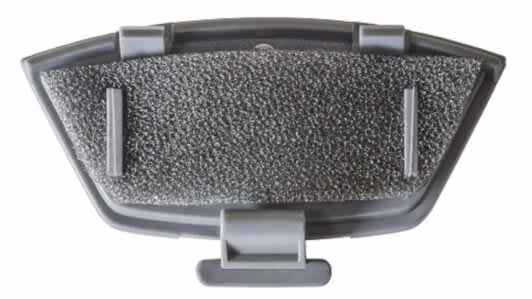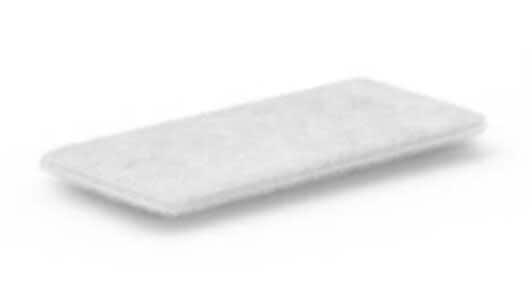On This Page
The Best CPAP Filters of 2025
Our Top Picks
-
Best for ResMed Users
ResMed AirCurve and AirSense 10 Replacement Filters -
Best for Travel
ResMed Replacement Fine Filters for AirMini -
Best for Transcend Users
Transcend 3 Somnetics Filter Assembly -
Best for Luna Users
Luna G3 Disposable Filter -
Best for iBreeze Users
Sunset Resvent iBreeze Replacement Air Filters
Best for ResMed Users

ResMed AirCurve and AirSense 10 Replacement Filters are designed to keep out mold and other allergens while you sleep.
Pros & Cons
Pros
- Affordable price
- Compatible with several ResMed devices
- Subscription available
Cons
- Designed exclusively for ResMed users
- Not washable
- Not intended to trap the smallest particles
Full Details
Best for Travel

Made of polyester fiber, these filters are crafted to fit seamlessly with the ResMed AirMini device.
Pros & Cons
Pros
- Specifically designed for the ResMed AirMini portable CPAP machine
- Fine mesh designed to keep out smaller particles
- Subscription available
Cons
- Slightly higher price-point
- Only compatible with the AirMini CPAP device
- Cannot be washed
Full Details
Best for Transcend Users

Made of foam and mounted on a specially shaped plastic holder, the Transcend 3 Somnetics Filter Assembly is a reusable filter engineered to trap allergens before they reach your airway.
Pros & Cons
Pros
- Three-month or six-month delivery available
- Competitively priced
- Sold with filter mount
Cons
- Designed to trap larger particles only
- Only compatible with the Transcend 3 device
- Sold as entire filter assembly, adding unnecessary waste
Full Details
Best for Luna Users

If you have a Luna G3 machine, you can choose between the standard reusable filter or a disposable alternative.
Pros & Cons
Pros
- More effective at fine particle filtration than the standard Luna reusable filter
- Better option for those sensitive to tobacco smoke
- Available in a convenient two-pack
Cons
- Higher ongoing cost compared with Luna reusable filters
- Not washable
- Requires more frequent replacement
Full Details
Best for iBreeze Users
Pros & Cons
Pros
- Easy to install
- No need to clean
- Compatible with both CPAP and BiPAP Resvent models
Cons
- Only one filter per pack
- Higher price-point than other disposable filters
- Not washable
Full Details
How We Make Our Picks
We analyze CPAP filter specifications to learn about fabrics, compatibility, durability, brand reputation, and quality. Using filters correctly can decrease your chance of inhaling allergens or dust, so it’s critical to get a filter that correctly fits your machine. In addition to studying product details, we also consider reviews from current users so that we can see how well a filter holds up to regular home use.
What Does a CPAP Filter Do?
As a CPAP machine pulls in air from the environment, CPAP filters help eliminate particles such as dust, pollen, animal dander, mold, and smoke from the air before it gets into the tubing and CPAP mask. The filter is an essential part of the CPAP machine, and a dirty filter can raise the risk of sickness or allergy symptoms, as well as shorten the device’s lifespan.
What Types of CPAP Filters are Available?
Standard CPAP machine filters come in two types: reusable or disposable. Most devices use just one type of filter, while some have a dual filtration system that allows you to use both simultaneously.
Reusable filters tend to consist of a thicker foam piece that traps larger particles, such as pollen. Disposable filters are made of thin, paper-like mesh material that holds an electrostatic charge to attract tiny particles.
Disposable Filters
Benefits
- Easier to keep clean
- Keep out smaller particles
Drawbacks
- Cost of buying disposable filters can add up over time
- Cannot be cleaned
Reusable Filters
Benefits
- Less frequent replacement schedule, meaning lower maintenance costs
- Tend to generate less waste
Drawbacks
- Must be cleaned regularly
- May not trap the smallest particles
In-line bacteria filters are an optional addition to CPAP machines. In-line filters, which typically attach between CPAP tubing and the machine’s air outlet, are designed to lower the risk of infection from bacteria. They are sometimes recommended for devices with a heated humidifier.
Reusable filters and disposable filters have different strengths. Disposable filters are excellent at trapping small particles like smoke and pollution, while reusable filters are better at catching pollen and pet dander.
How to Choose a CPAP Filter
Manufacturers often provide strict instructions for choosing a CPAP filter, as not all filters are compatible with a given device. However, within the limits of these recommendations, you should consider your own needs regarding factors like price, material quality, and how sensitive you are to allergens.
CPAP Filter Considerations
| Filter Type | Disposable, reusable, and in-line bacteria filters are each designed to trap a different type of contaminant. Depending on the compatibility with your CPAP machine, you may be able to choose the filter or filters that are most relevant to you. |
| Compatibility | Many CPAP machines have proprietary filters, which are the only ones that work with the device. Check the manufacturer’s guidelines to make sure your filter is compatible. Even if a filter has the same shape, using generic models or other brands may cause the filter to work ineffectively and may harm the machine. |
| Price | Disposable filters are usually cheap, but the cost of buying them every few months can add up over time. Some insurance plans may cover the cost of these and other CPAP replacement parts. Alternatively, you may be able to sign up for a subscription plan and save a small percentage on the cost per filter. |
| Allergens | Reusable CPAP filters are generally designed to keep out major allergens, such as pollen, dust, and animal dander. If you are particularly sensitive to smaller airborne contaminants such as smoke, consider a machine that uses a reusable filter, which is engineered to catch smaller particles. People prone to sinus or respiratory infections may want to consider adding an in-line bacteria filter. |
| Material Quality | Whereas reusable filters often feature thicker foam to absorb particles, disposable filters may use thin paper or synthetic fiber to attract smaller contaminants. The user guide may state the minimum particle size the filter is capable of trapping, with reusable models generally filtering particles down to 7 microns and disposable filters trapping particles as small as 0.5 microns. |
Filters aren’t always universally compatible, so you’ll need to check to see if the filter you have in mind will work with your CPAP machine. Check your filter for tears or holes regularly too.
How Often Should You Replace Your CPAP Filter?
Generally, disposable filters need replacing twice a month and reusable filters should be replaced twice a year. In-line bacteria filters generally need to be replaced once per month. Each manufacturer has its own recommended replacement schedule, so be sure to check the instructions for your model.
Worn or dirty filters cannot clean the air as efficiently, which leaves CPAP users susceptible to airborne contaminants. A clogged filter may also cause the machine to overheat, which can cause damage to the machine or affect the way it works.
| CPAP Filter Type | Replacement Timeline |
| Disposable Filters | 2 weeks |
| Reusable Filters | 6 months |
| In-line Filters | 1 month |
Signs Your CPAP Filter Should be Replaced
You may need to change your CPAP filter ahead of schedule if you notice any of these signs:
- Holes, tears, discoloration, or visible debris on the filter
- Signs of wear, such as the foam breaking down
- Louder noise than usual
- Irritated nose, throat, or eyes
- Warmer-than-usual airflow
- Ineffective CPAP therapy
Households with cigarette smoke, pet dander, or other sources of contaminated air, such as being located in a polluted area, may find that CPAP filters need replacing more frequently than usual.
If you’re using an in-line bacteria filter, you should also check it frequently to make sure there is no moisture buildup, as this could affect the air pressure.
Where to Buy CPAP Filters
Many online retailers offer CPAP filters for one-time purchase or as part of a subscription plan. Your CPAP manufacturer may be able to direct you to a third-party supplier. CPAP filters are also sold in physical stores such as Walmart or specialty CPAP supply stores.
Does Insurance Cover CPAP Filters?
Medicare covers up to two disposable filters per month or one reusable filter every six months. Coverage under Medicaid or other insurance plans may vary. Before purchasing CPAP filters, confirm eligibility and the filter replacement schedule with your plan provider.
Can an FSA or HSA be Used to Buy CPAP Filters?
As a necessary component of CPAP supplies, filters should qualify for purchase through a flexible spending account or health savings account. Check with your plan provider before allocating funds for this use.
Frequently Asked Questions
Reusable filters cost around $6 to $20, while disposable filters generally run between $2 and $6 per unit. In-line bacteria filters may set you back around $5. Buying more than one filter at a time may lower the cost per filter.
To clean a reusable CPAP filter, unplug the machine, locate the filter door on the back or side of the machine, and remove the filter. Wash the filter under running water or with mild soap and warm water, then gently shake or squeeze out the excess water. Let it dry fully before reassembling the filter and inserting it back into the machine.
You should repeat this cleaning process at least once a week. Check the user guide for cleaning instructions specific to your model.
CPAP machines should not be used without a filter. Since the device takes air from the surrounding environment, the filter is important for removing contaminants before you inhale them, and for ensuring the proper functioning of the machine.

